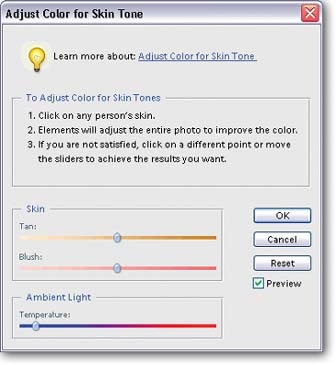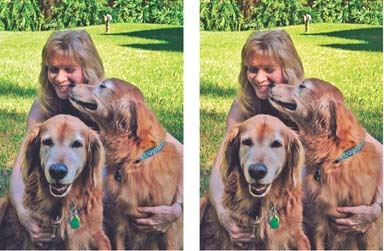If you're like most amateur photographers, your most important photos are pictures of people: your family, your friends, or even just fascinating strangers. Elements 4 includes another new tool for making fast fixesâone that's designed especially for correcting photos that have people in them. The new tool is the Adjust Skin Tone command, available in both the Quick Fix and the Standard Editor.
The name "Adjust Color for Skin Tone" may be a bit confusing. What this command actually does is to adjust your entire image based on the skin tone of someone in the photo. The idea behind Adjust Skin Tone is that you may well be much more interested in the way the people in your photos look than in how the background looks. This command gives the highest priority to creating good skin color. It's an automatic fix, but there's a dialog box where you can tweak the results once you've previewed Elements' suggested adjustments. To use the Adjust Skin Tones command:
Call up the Adjust Color for Skin Tone dialog box.
In either the Quick Fix or the Standard Editor, go to Enhance â Adjust Color â Adjust Color for Skin Tone. The dialog box shown in Figure 4-11 appears. You may need to move it out of the way of your photo so that you can see what's happening.
Show Elements an area of skin to sample for calculating the color adjustments.
Once the Adjust Color for Skin Tone dialog box appears, your cursor turns to an eyedropper. Just find a portion of your photo subject's skin that has relatively good color, and click it.
Tweak the results
Most of the time, Elements is a bit overenthusiastic in its adjustments. Use the sliders in the dialog box to get a more pleasing, realistic color. The Temperature slider works just like the one in the Quick Fix control panel (Section 4.2.4.2). Blush increases the rosiness of the skin as you move the slider to the right and decreases it to the left. Tan increases or decreases the browns and oranges in the skin tones. You'll probably find that you need to use all the sliders to get a truly realistic result.
Figure 4-11. When this dialog box appears, your cursor turns to a little eyedropper when you move it over your photo. Just click with it on the best-looking area of skin you can find in your photo. After Elements adjusts the photo based on your click, you can use the sliders to fine-tune the results. Clicking different spots gives different results, so you may want to experiment by clicking different places.
Tip
The Adjust Color for Skin Tone sliders are like the Quick Fix sliders in that you can get an idea of which way to move them by looking at the colors in the slider tracks in the dialog box.
You can preview the changes right in your photo as you work. If you mess up and want to start again, click Reset. If you decide you'd rather be using another tool instead, click Cancel.
When you like what you see, click Okay.
Elements applies your changes. If you want to undo them, press Ctrl+Z.
Adjust Color for Skin Tone seems to work best on fair skin, and not so well on darker skin tones. And it's most suited for making fairly subtle adjustments, so you may have to reduce the amount of change from what Elements first did.
Also, notice that not only the skin tones are changing. Elements is adjusting all the colors in the photo in sync with the skin tones. You may find you've acquired quite a color cast (Section 7.4.1) by the time you've got the skin just right, as you can see in Figure 4-12. If this bothers you, try a different tool. On the other hand, you can create some very nice late afternoon light effects with this command.
While Adjust Color for Skin Tone is really meant as a kind of alternative fast fix, you may find it's most useful for making small final adjustments to photos you've already edited using other tools.
Figure 4-12. Left: The skin tones in the original photo are slightly bluish and a tad washed out. Right: Adjust Skin Tone is able to warm up not only skin tones, but also the coats of the dogs. If you look closely, you can see that it also introduces a bit of an orange cast to the grass.
Tip
If you understand layers (explained in Chapter 6), you may want to make a duplicate layer and apply this command to your duplicate. Then you can adjust the intensity of the result by adjusting the layer's opacity (see Section 6.3).
Get Photoshop Elements 4: The Missing Manual now with the O’Reilly learning platform.
O’Reilly members experience books, live events, courses curated by job role, and more from O’Reilly and nearly 200 top publishers.



